一、spring介绍
1.三层架构中spring位置
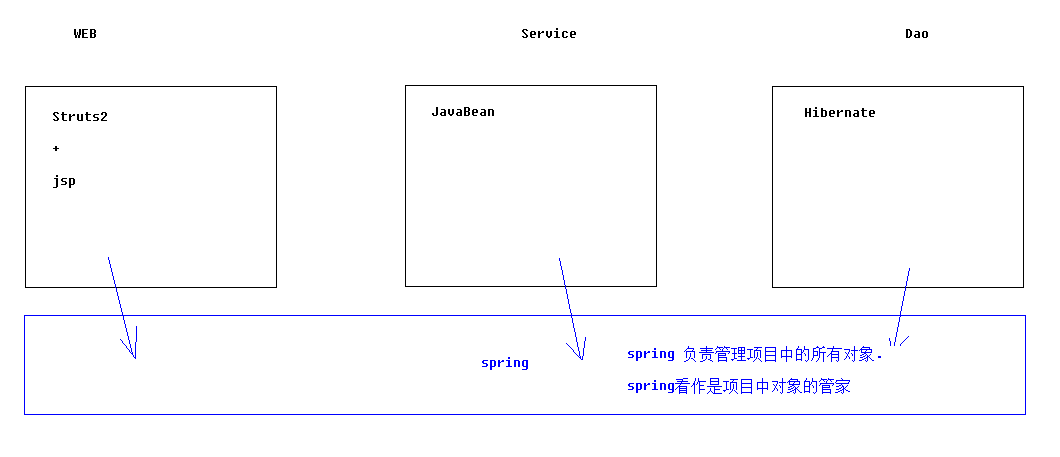
2.spring一站式框架
正是因为spring框架性质是属于容器性质的.
容器中装什么对象就有什么功能.所以可以一站式.
不仅不排斥其他框架,还能帮其他框架管理对象.
aop支持、ioc思想、spring jdbc、aop 事务、junit 测试支持
二、spring搭建
1.导包


日志包:com.springsource.org.apache.commons.logging-1.1.1.jar
可选:com.springsource.org.apache.log4j-1.2.15.jar(老版本要导入的,导入可以保证一定能运行)
2.创建一个对象
public class User { private String name; private Integer age; public String getName() { return name; } public void setName(String name) { this.name = name; } public Integer getAge() { return age; } public void setAge(Integer age) { this.age = age; } }
3.书写配置注册对象到容器
位置任意(建议放到src下)
配置文件名任意(建议applicationContext.xml)
导入约束:
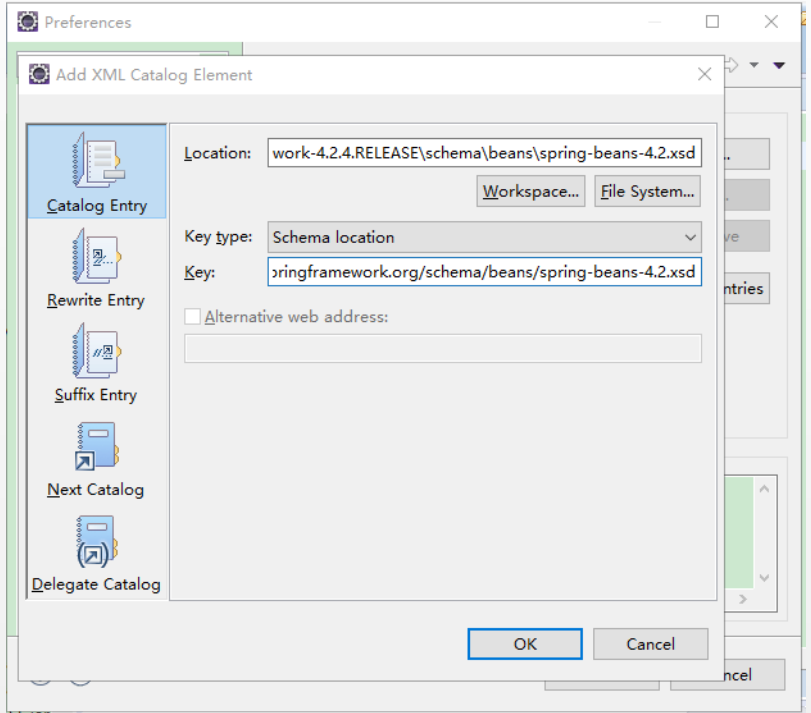
然后编辑applicationContext.xml,加入<beans></beans>后切换带设计视图

进入编辑后点击add,导入xsi

添加完xsi后,再次点击add,指定一个新的命名空间
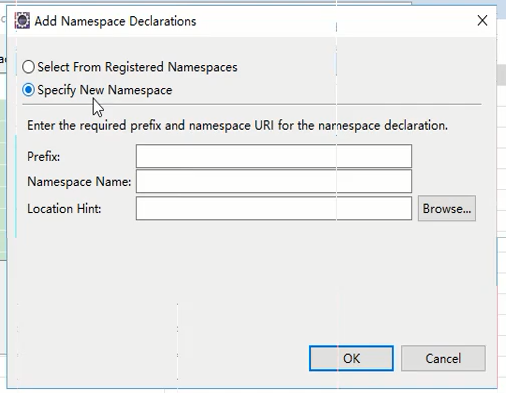
然后选择刚刚导入的xsd
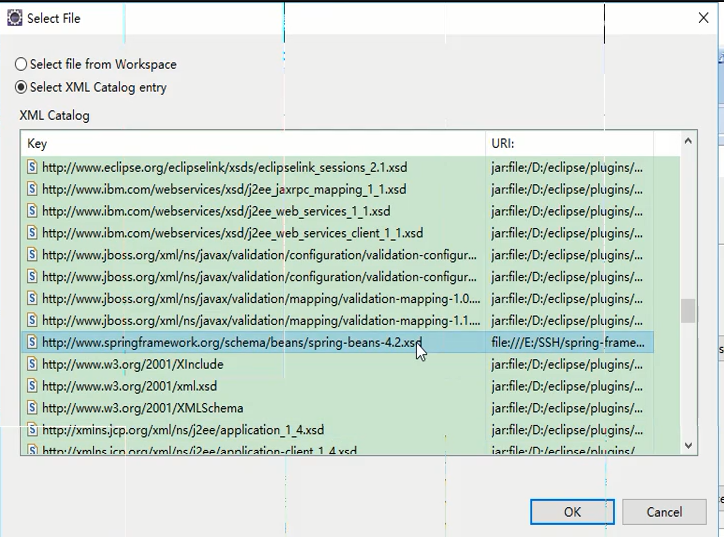
点击OK,回到刚刚的页面,设置命名空间的名字(可以直接复制location Hint的前半段),prefix空着即可
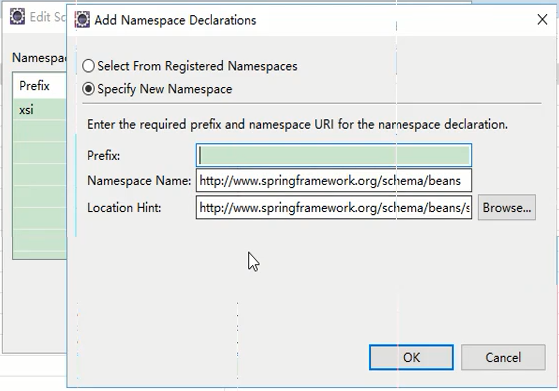
点击OK,显示为下面的界面,就说明导入成功了。
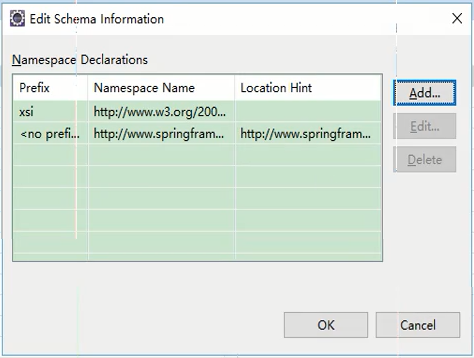
书写applicationContext.xml:
<?xml version="1.0" encoding="UTF-8"?> <beans xmlns:xsi="http://www.w3.org/2001/XMLSchema-instance" xmlns="http://www.springframework.org/schema/beans" xsi:schemaLocation="http://www.springframework.org/schema/beans http://www.springframework.org/schema/beans/spring-beans-4.2.xsd "> <!-- 将User对象交给spring容器管理 --> <bean name="user" class="cn.itcast.bean.User" ></bean> </beans>
4.代码测试
@Test public void fun1(){ //1 创建容器对象 ApplicationContext ac = new ClassPathXmlApplicationContext("applicationContext.xml"); //2 向容器"要"user对象 User u = (User) ac.getBean("user"); //3 打印user对象 System.out.println(u); }
三、spring概念
1.思想
1.1 ioc

1.2 di
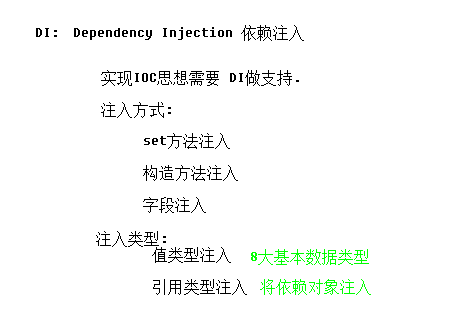
2.applicationContext&BeanFactory
2.1 BeanFactory接口
spring原始接口.针对原始接口的实现类功能较为单一;
BeanFactory接口实现类的容器.特点是每次在获得对象时才会创建对象。
2.2 ApplicationContext
每次容器启动时就会创建容器中配置的所有对象.并提供更多功能。
从类路径下加载配置文件:ClassPathXmlApplicationContext
2.3 结论
结论:web开发中,使用applicationContext. 在资源匮乏的环境可以使用BeanFactory.
四、spring配置详解
1.Bean元素
<!-- 将User对象交给spring容器管理 --> <!-- Bean元素:使用该元素描述需要spring容器管理的对象 class属性:被管理对象的完整类名. name属性:给被管理的对象起个名字.获得对象时根据该名称获得对象. 可以重复.可以使用特殊字符. id属性: 与name属性一模一样. 名称不可重复.不能使用特殊字符. 结论: 尽量使用name属性. --> <bean name="user" class="cn.itcast.bean.User" ></bean>
2.Bean元素进阶
2.1 scope属性
singleton(默认值):单例对象.被标识为单例的对象在spring容器中只会存在一个实例
prototype:多例原型.被标识为多例的对象,每次再获得才会创建.每次创建都是新的对象.整合struts2时,ActionBean必须配置为多例的.
request:web环境下.对象与request生命周期一致.
session:web环境下,对象与session生命周期一致.
2.2 生命周期属性
init-method:配置一个方法作为生命周期初始化方法.spring会在对象创建之后立即调用.
destory-method:配置一个方法作为生命周期的销毁方法.spring容器在关闭并销毁所有容器中的对象之前调用.
<bean name="user" class="cn.itcast.bean.User" init-method="init" destroy-method="destory" ></bean>
3.spring创建对象的方式
<!-- 创建方式1:空参构造创建(重点) --> <bean name="user" class="cn.itcast.bean.User" init-method="init" destroy-method="destory" ></bean> <!-- 创建方式2:静态工厂创建 (了解) 调用UserFactory的createUser方法创建名为user2的对象.放入容器 --> <bean name="user2" class="cn.itcast.b_create.UserFactory" factory-method="createUser" ></bean> <!-- 创建方式3:实例工厂创建 (了解) 调用UserFactory对象的createUser2方法创建名为user3的对象.放入容器 --> <bean name="user3" factory-bean="userFactory" factory-method="createUser2" ></bean> <bean name="userFactory" class="cn.itcast.b_create.UserFactory" ></bean>
4.spring的分模块配置
<!-- 导入其他spring配置文件 --> <import resource="cn/itcast/b_create/applicationContext.xml"/>
五、spring属性注入
1.注入方式
1.1 set方法注入(重中之重)
<!-- set方式注入: --> <bean name="user" class="cn.itcast.bean.User" > <!--值类型注入: 为User对象中名为name的属性注入tom作为值 --> <property name="name" value="tom" ></property> <property name="age" value="18" ></property> <!-- 引用类型注入: 为car属性注入下方配置的car对象 --> <property name="car" ref="car" ></property> </bean> <!-- 将car对象配置到容器中 --> <bean name="car" class="cn.itcast.bean.Car" > <property name="name" value="兰博基尼" ></property> <property name="color" value="黄色" ></property> </bean>
1.2 构造函数注入(重点)
<!-- 构造函数注入 --> <bean name="user2" class="cn.itcast.bean.User" > <!-- name属性: 构造函数的参数名 --> <!-- index属性: 构造函数的参数索引 --> <!-- type属性: 构造函数的参数类型--> <constructor-arg name="name" index="0" type="java.lang.Integer" value="999" ></constructor-arg> <constructor-arg name="car" ref="car" index="1" ></constructor-arg> </bean>
1.3 p名称空间注入
<!-- p名称空间注入, 走set方法 1.导入P名称空间 xmlns:p="http://www.springframework.org/schema/p" 2.使用p:属性完成注入 |-值类型: p:属性名="值" |-对象类型: p:属性名-ref="bean名称" --> <bean name="user3" class="cn.itcast.bean.User" p:name="jack" p:age="20" p:car-ref="car" > </bean>
1.4 spel注入
<!-- spel注入: spring Expression Language sping表达式语言 --> <bean name="user4" class="cn.itcast.bean.User" > <property name="name" value="#{user.name}" ></property> <property name="age" value="#{user3.age}" ></property> <property name="car" ref="car" ></property> </bean>
2.复杂类型注入
2.1 数组
<!-- 如果数组中只准备注入一个值(对象),直接使用value|ref即可 <property name="arr" value="tom" ></property> --> <!-- array注入,多个元素注入 --> <property name="arr"> <array> <value>tom</value> <value>jerry</value> <ref bean="user4" /> </array> </property>
2.2 List
<!-- 如果List中只准备注入一个值(对象),直接使用value|ref即可 <property name="list" value="jack" ></property>--> <property name="list" > <list> <value>jack</value> <value>rose</value> <ref bean="user3" /> </list> </property>
2.3 Map
<!-- map类型注入 --> <property name="map" > <map> <entry key="url" value="jdbc:mysql:///crm" ></entry> <entry key="user" value-ref="user4" ></entry> <entry key-ref="user3" value-ref="user2" ></entry> </map> </property>
2.4 Properties
<!-- prperties 类型注入 --> <property name="prop" > <props> <prop key="driverClass">com.jdbc.mysql.Driver</prop> <prop key="userName">root</prop> <prop key="password">1234</prop> </props> </property>
六、练习:将spring容器应用到struts-crm项目
管理Service对象以及Dao对象
1.导包(4+2),再加1
再加1指的是:spring-web-4.2.4.RELEASE.jar(因为要用到web的监听)
2.将Service对象以及Dao对象配置到spring容器(注入属性记得加相应的set方法)
<?xml version="1.0" encoding="UTF-8"?> <beans xmlns:xsi="http://www.w3.org/2001/XMLSchema-instance" xmlns="http://www.springframework.org/schema/beans" xsi:schemaLocation="http://www.springframework.org/schema/beans http://www.springframework.org/schema/beans/spring-beans-4.2.xsd "> <!-- 配置Dao --> <bean name="customerDao" class="cn.itheima.dao.impl.CustomerDaoImpl" ></bean> <bean name="linkManDao" class="cn.itheima.dao.impl.LinkManDaoImpl" ></bean> <bean name="userDao" class="cn.itheima.dao.impl.UserDaoImpl" ></bean> <!-- 配置Service --> <bean name="customerService" class="cn.itheima.service.impl.CustomerServiceImpl" > <property name="customerDao" ref="customerDao" ></property> </bean> <bean name="linkManService" class="cn.itheima.service.impl.LinkManServiceImpl" > <property name="cd" ref="customerDao" ></property> <property name="lmd" ref="linkManDao" ></property> </bean> <bean name="userService" class="cn.itheima.service.impl.UserServiceImpl" > <property name="ud" ref="userDao" ></property> </bean> </beans>
3.在Action中获得容器中的Service对象
3.1 web.xml中配置容器随项目启动
<!-- 可以让spring容器随项目的启动而创建,随项目的关闭而销毁 --> <listener> <listener-class>org.springframework.web.context.ContextLoaderListener</listener-class> </listener> <!-- 指定加载spring配置文件的位置 --> <context-param> <param-name>contextConfigLocation</param-name> <param-value>classpath:applicationContext.xml</param-value> </context-param>
3.2 在Action中获得容器
//获得spring容器=>从Application域获得即可 //1 获得servletContext对象 ServletContext sc = ServletActionContext.getServletContext(); //2.从Sc中获得ac容器 WebApplicationContext ac = WebApplicationContextUtils.getWebApplicationContext(sc); //3.从容器中获得CustomerService UserService us = (UserService) ac.getBean("userService");
4.管理容器在项目中的生命周期
下面错误的示范.导致每次请求都创建新的容器
//创建容器对象 ApplicationContext ac = new ClassPathXmlApplicationContext("applicationContext.xml"); //获得cs(customerService对象) CustomerService cs = (CustomerService) ac.getBean("customerService");